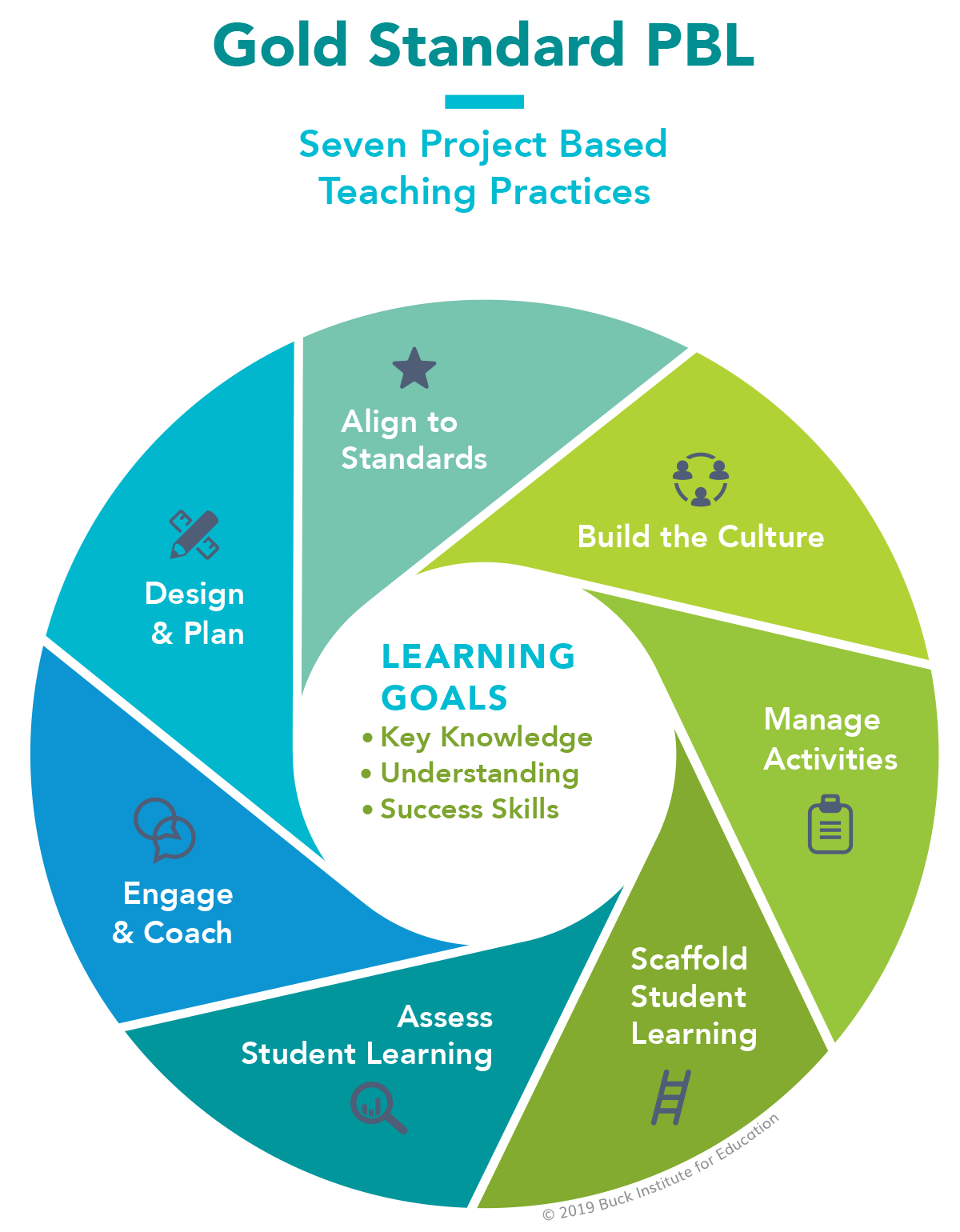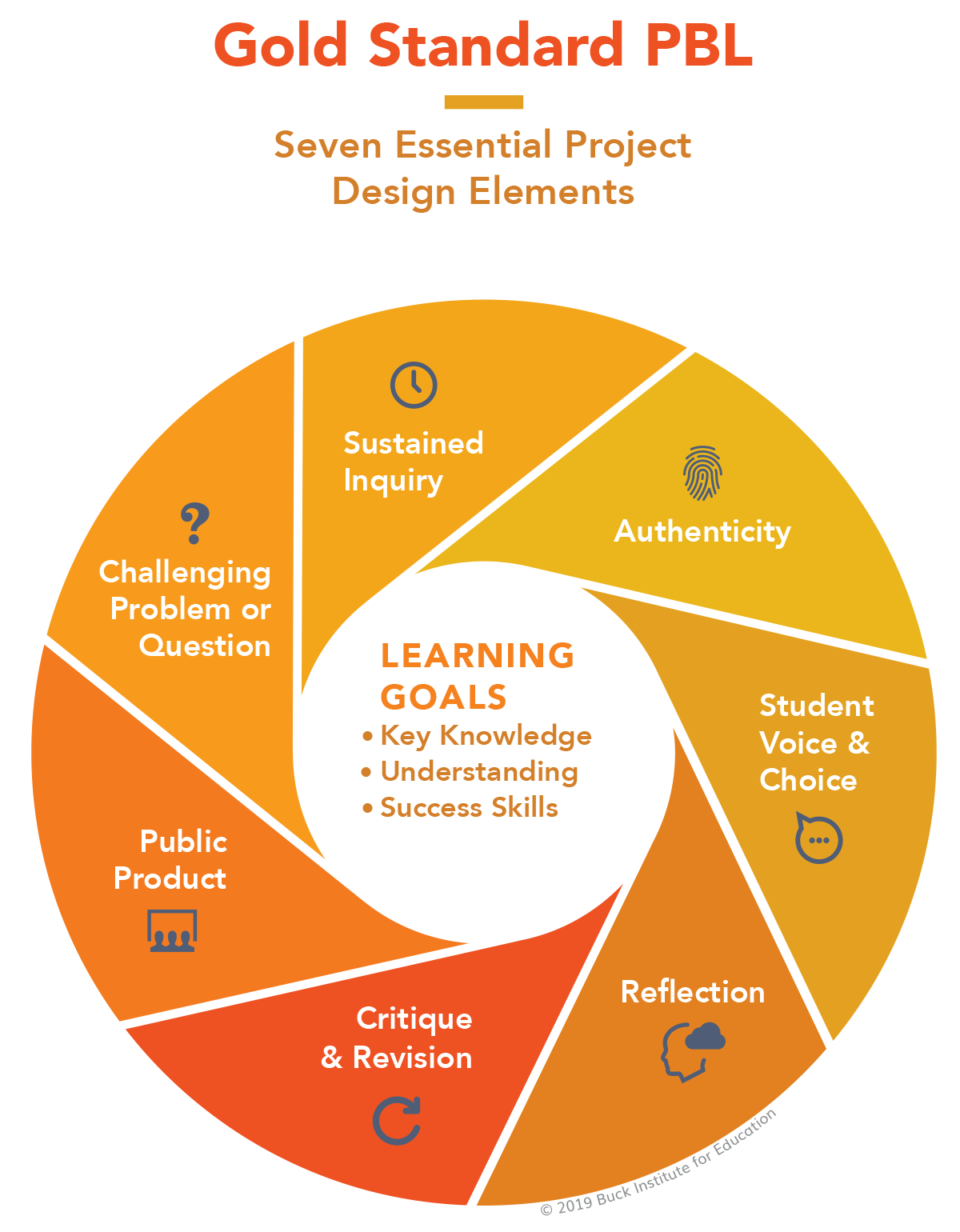What is Project Based Learning?
Project Based Learning (PBL) is a teaching method in which students learn by actively engaging in real-world and personally meaningful projects.
Students work on a project over an extended period of time – from a week up to a semester – that engages them in solving a real-world problem or answering a complex question. They demonstrate their knowledge and skills by creating a public product or presentation for a real audience.
As a result, students develop deep content knowledge as well as critical thinking, collaboration, creativity, and communication skills. Project Based Learning unleashes a contagious, creative energy among students and teachers. Health Education provides engaging and complex content that provides a foundation for PBL's. PBL is for all students consider how you can leverage students grouping, and Universal Design Principles to support all students.
The Buck Institute for Education PBL Works has identified 7 Gold Standard PBL Teaching practices. Identified in the graphic below. As you are working through creation of PBL's these practices should be followed.

Seven Project Based Teaching Practices
Design & Plan
Teachers create or adapt a project for their context and students, and plan its implementation from launch to culmination while allowing for some degree of student voice and choice. Consider starting with a smaller short term project with a specific focus.
Align to Standards
Teachers use standards to plan the project and make sure it addresses key knowledge and understanding from subject areas to be included. Start with the health education standards and the health skills, but consider how a PBL can and should address multiple standards across multiple content areas.
Build the Culture
Teachers explicitly and implicitly promote student independence and growth, open-ended inquiry, team spirit, and attention to quality. In building a positive classroom culture consider teaching explicit health skills such as communication skills, collaboration and decision making skills. Consider how you will explicitly teach and provide opportunities for practice of these skills prior to the PBL.
Manage Activities
Teachers work with students to organize tasks and schedules, set checkpoints and deadlines, find and use resources, create products and make them public.
Scaffold Student Learning
Teachers employ a variety of lessons, tools, and instructional strategies to support all students in reaching project goals.
Assess Student Learning
Teachers use formative and summative assessments of knowledge, understanding, and success skills, and include self and peer assessment of team and individual work.
Engage & Coach
Teachers engage in learning and creating alongside students, and identify when they need skill-building, redirection, encouragement, and celebration.
Seven Essential Project Design Elements
The Buck Institute for Education PBL Works has a identified seven essential project design elements when creating PBL's. These elements are related to how teachers can design PBL project.

A Challenging Problem or Question
The project is framed by a meaningful problem to be solved or a question to answer, at the appropriate level of challenge. Consider how you will engage students in identifying problems based on the standards. Use an engaging hook to spark interest and passion for deeper inquiry, such as a current event, guest speaker, or video clip. Often a quick news clip of a teenager doing awesome things is all it takes to spur students on to do the same. Engage parents or local community experts or partners to present to students.
Sustained Inquiry
Students engage in a rigorous, extended process of posing questions, finding resources, and applying information. This is an interactive process that occurs throughout the PBL process.
Authenticity
The project involves real-world context, tasks and tools, quality standards, or impact, or the project speaks to personal concerns, interests, and issues in the students’ lives.
Student Voice & Choice
Students make some decisions about the project, including how they work and what they create.
Reflection
Students and teachers reflect on the learning, the effectiveness of their inquiry and project activities, the quality of student work, and obstacles that arise and strategies for overcoming them.
Critique & Revision
Students give, receive, and apply feedback to improve their process and products.
Public Product
Students make their project work public by explaining, displaying and/or presenting it to audiences beyond the classroom.
Examples of PBL's in Health Education.
The following recorded webinar provides a framework and examples of using PBL's in Health Education.
PBL Starters from Health Teacher Blog:
* this post originally appeared on Choices.Scholastic.com / https://thehealthteacher.com/12-grab-go-projects-for-health/
As a head start, here are some ready-to-go projects you can adapt them to your class as needed. Just click on the project title for a step-by-step outline.
Students research The Blue Zones, five areas of the world where people are most likely to live to be over 100. After learning about the healthy behaviors that lead to longevity, students set “Blue Zone” goals to implement within their homes and communities.
Students analyze food packaging health claims by making a trip to the grocery store, taste-testing energy bars, then creating and marketing their own healthy bars, complete with product boxes and a commercial.
Let’s be real: The FDA’s new dietary guidelines are more confusing than ever. To learn to love real food, rather than fear food data, students will research dietary guidelines from around the world and create a set of guidelines for your school, using journalist Michael Pollan’s Food Rules as an aid.
After watching an inspirational documentary about a group of kids who bettered the lunch options in their school’s cafeteria, students work to make change in their own school with the help of an awesome advocacy kit from DoSomething.org.
Family values play a key role in the decision-making process, and as teens gain more freedom, sticking to those values will help keep them safe from high-risk behaviors. In this project, students have a conversation with their parents to create a list of core values and a mission statement for their family.
Research on the impact of alcohol and the teenage brain is updated almost constantly. Rather than give the students the facts, let them find out for themselves as they dig up the latest details on the risks of underage drinking.
Using resources provided as a launching point, students will create their own inquiry-based project to learn more about e-cigarettes.
Today’s teens are horribly sleep deprived, and many of them don’t understand all of the ways that it’s negatively impacting their health. In this project, they’ll research the benefits of sleep and create an advocacy campaign to convince their classmates to get more shut-eye.
This unit plan ends on a positive note, with students making videos of their favorite healthy coping skills and stress busters. (This one is always a highlight for my sixth grade students.)
Rather than take the anti-bullying angle, this project has students use a medium of their choice to encourage and support others via positive prevention methods.
In this cross-curricular project, health classes and art classes team up to create a public service announcement and a logo for an advocacy campaign of their conception.
So often we focus on the negative when talking to kids about social media, but in reality, they’re using social media to do amazing things to bring about positive social change. In this project, students find an advocacy group on social media that inspires them and present what they learned to the class.
Don’t have enough time to fit in a full project with your class? Team up with a colleague from another subject and check out these ideas for cross-curricular learning.